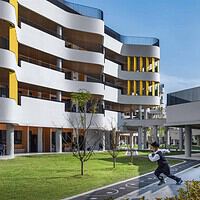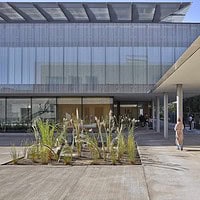As the demand for sustainable construction methods soars, metal buildings are receiving significant attention due to their potential for eco-friendly construction. Metal, as a building material, is lauded for its durability, recyclability, and energy efficiency. These attributes make it an appealing choice for projects aiming to reduce environmental impact. The construction industry recognizes the importance of sustainability, considering the vast consumption of resources and the production of waste associated with traditional building processes.
Sustainable Design and Construction in Metal Buildings
Innovative Design for Sustainability
Innovative design in metal buildings focuses on reducing environmental impact while maintaining functionality. Strategies such as modular construction enable ease of expansion and adaptability. The use of pre-engineered components reduces waste and on-site work, leading to less disruption and pollution.
Material and Resource Efficiency
Materials used in metal buildings, primarily steel and iron, are advantageous in sustainability due to their recyclability and durability. Optimization techniques in the design phase aim to minimize material usage. Furthermore, recycling construction waste and using products with high recycled content has become an industry benchmark.
Energy Efficiency and Climate Control
Metal buildings are designed for optimal energy efficiency. Features like reflective coatings on roofing materials minimize heat absorption. The integration of solar panels and effective insulation systems reduces energy consumption for heating and cooling, contributing to a significant decrease in the building’s carbon footprint.
Sustainability Regulations and Standards
Government policies and regulations play a pivotal role in promoting sustainable construction. Standards such as LEED and BREEAM evaluate and certify buildings on various aspects of sustainability. Compliance with these frameworks ensures that metal buildings meet high environmental performance levels.
Data-Driven Sustainability in Construction
Big Data and Analytics in Eco-Friendly Construction
Big data and analytics are increasingly vital in constructing sustainable buildings. By analyzing extensive datasets, construction firms can pinpoint areas to optimize resource usage and reduce waste. Innovative big data technologies enable the evaluation of a variety of factors such as material durability, energy consumption patterns, and even the environmental impact of construction methods. Here, the focus is on:
- Energy Efficiency: Using predictive analytics to enhance building design for reduced energy usage.
- Resource Management: Monitoring raw material consumption to minimize waste.
Artificial Intelligence for Building Lifecycle Management
Artificial intelligence (AI) is revolutionizing building lifecycle management. It extends beyond construction to include maintenance and demolition, ensuring the sustainability of buildings from inception to deconstruction. AI’s role in lifecycle management includes:
- Predictive Maintenance: AI algorithms predict when building components need repair, therefore extending their life and conserving resources.
- Demolition Planning: AI supports recycling and reusing materials by identifying the most sustainable methods of building deconstruction.
Emerging Technologies for Smart Construction
Emerging technologies are laying the groundwork for smart construction, which is central to the development of sustainable and smart cities. Ecological innovation through new technologies aims to minimize the environmental footprint of buildings. Key technologies include:
- 3D Printing: Reducing material waste and allowing for the production of complex, tailor-made building components.
- Green Materials: Advancements in material technology lead to more sustainable construction without compromising quality.
Economic and Environmental Impact
Metal buildings have become a significant part of the construction sector due to their sustainability and reduced environmental impact. The economic benefits combined with the capacity to lower carbon emissions and waste generation make them an asset for a sustainable economy.
Reducing the Carbon Footprint of Metal Buildings
Metal buildings have the potential to greatly reduce the carbon footprint within the construction sector. The use of steel, which is often a primary material in metal buildings, provides the advantage of being recyclable and thus contributes to lower greenhouse gas emissions during production.
- Recyclability: Steel’s inherent recyclability means less raw material is needed, as scrap steel can be reused effectively.
- Energy Efficiency: Modern metal buildings are often designed to be energy-efficient, with better insulation and reduced thermal bridging, leading to lower emissions from heating and cooling.
Economy of Sustainability in the Construction Sector
The push towards sustainability is not only environmentally sound but also economically beneficial. Investing in sustainable practices within the construction sector can lead to economic growth by creating new markets and jobs related to eco-friendly materials and technologies.
- Long-term Savings: Metal buildings typically require less maintenance, which translates to cost savings over time.
- Job Creation: The demand for skilled labor in sustainable construction technologies promotes job growth in these emerging fields.
Construction Waste Management and Pollution Control
Effective waste management in construction is crucial for minimizing the environmental impact of metal buildings. A focus on reducing waste generation and implementing pollution control measures can ensure that metal buildings are part of a sustainable economy.
- Waste Reduction: Prefabrication of components in a controlled factory setting leads to precise construction, with reduced onsite waste.
- Pollution Mitigation: By following stringent regulations and employing state-of-the-art pollution control technologies, the sector can effectively reduce its contribution to land, water, and air pollution.
By integrating these practices, the construction of metal buildings can play a pivotal role in sustaining environmental health and driving economic prosperity.
Case Studies and Global Trends
Singapore’s Approach to Sustainable Metal Construction
Singapore, a leader in urban sustainability, has been at the forefront of embedding sustainable practices in its construction industry. The country has effectively leveraged technology and innovation to create metal structures that complement its vision for a sustainable economy. Notably, Singapore’s Building and Construction Authority (BCA) has instituted the Green Mark Scheme, encouraging environmentally-friendly construction. As a result, metal buildings in Singapore are increasingly constructed with recycled content, adaptive reuse in mind, and energy-efficient systems, setting a recurring theme for sustainable cities.
Eco-Town and Eco-District Initiatives Worldwide
Eco-towns and eco-districts represent a rising global trend in sustainable urban development. These initiatives prioritize green construction practices, often including the use of metal for its recyclability and durability.
- Japan’s Fujisawa Sustainable Smart Town: Harnessing solar panels and energy storage systems, it epitomizes global eco-city trends.
- Germany’s Vauban: A district in Freiburg that extensively employs renewable materials, including metal, showcasing economic development alongside environmental stewardship.
These cases reflect the global shift toward eco-districts that not only promise sustainable living but also propel the broader objectives of eco-cities.















